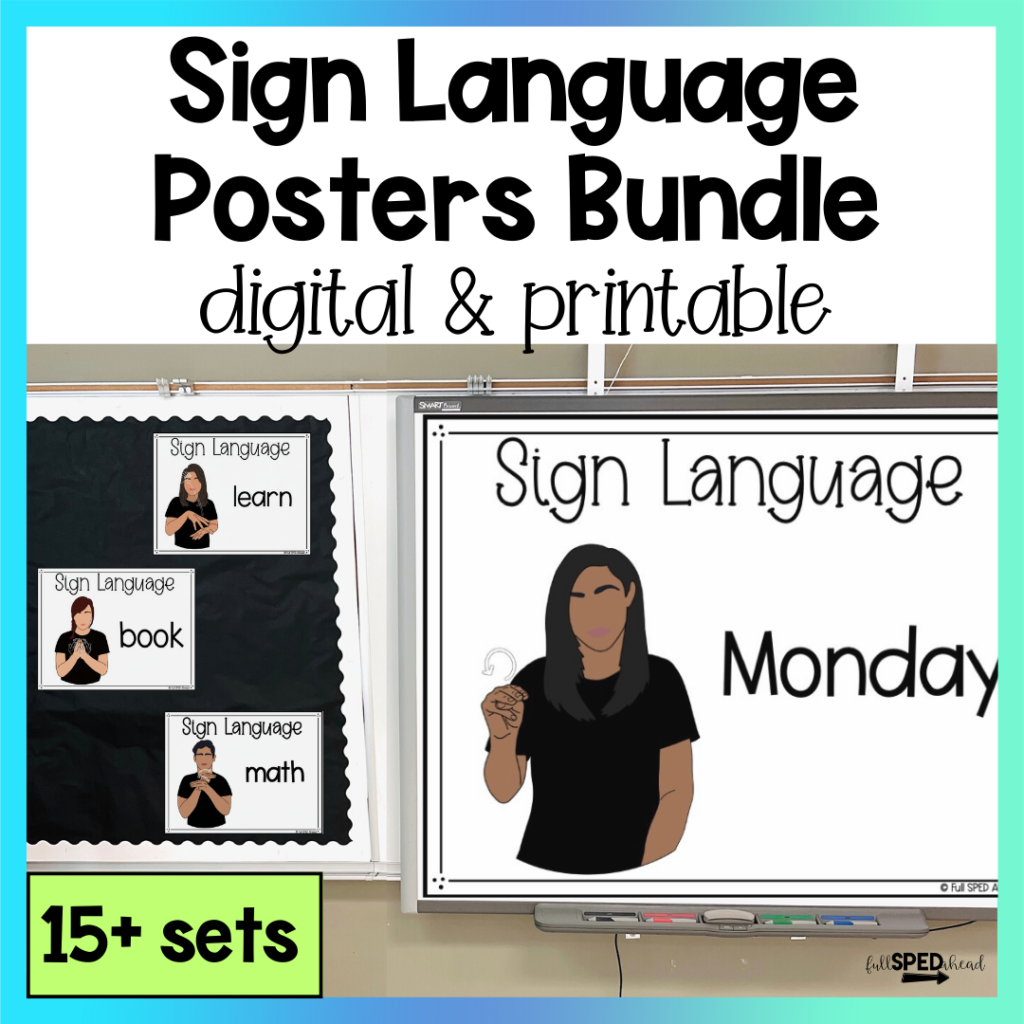What is sign language called? American Sign Language (ASL) is a visual-gestural language used by the Deaf community that offers numerous benefits for special education learners. ASL not only serves as a means of communication but also enhances cognitive, linguistic, and social-emotional development.
In special education classrooms, incorporating sign language can promote inclusivity, support language acquisition, and foster communication skills. In this blog post, we will explore the various benefits of using sign in special education settings and highlight the valuable resource, the American Sign Language (ASL) Google Slides Lessons, Classroom Decor & Posters Bundle, available on Teachers Pay Teachers.
ASL serves as an effective communication tool for students with communication challenges or those who struggle with verbal expression. By incorporating sign into the classroom, educators can provide an alternative mode of communication that allows students to express their thoughts, needs, and emotions. Sign Language can support language development by reinforcing vocabulary, grammar, and syntax. Research has shown that incorporating sign language alongside spoken language can improve language comprehension, expressive language skills, and overall communication abilities in special education learners.

Inclusive education aims to create learning environments that accommodate the diverse needs of all students. Sign plays a significant role in fostering inclusivity by providing a means of communication that is accessible to individuals with hearing impairments or language processing difficulties. By incorporating sign language into the classroom, educators create an inclusive space where students with hearing impairments can actively participate in discussions, engage with their peers, and access information effectively. This promotes a sense of belonging and equal opportunities for all students, fostering a supportive and inclusive learning environment.
The visual nature of ASL engages multiple cognitive processes, leading to enhanced cognitive and linguistic skills in special education learners. Research suggests that signing activates different areas of the brain, promoting cognitive flexibility, memory retention, and spatial-temporal skills. By learning and using ASL, students can improve their visual-spatial awareness, attention to detail, and overall cognitive functioning. Additionally, ASL exposure can positively impact reading and writing skills by strengthening phonological awareness and expanding vocabulary.
In addition to its impact on communication, the use of American Sign Language in special education classrooms has been found to have significant benefits for cognitive and linguistic development. The visual nature of sign language engages multiple cognitive processes, stimulating various areas of the brain and promoting cognitive flexibility, memory retention, and spatial-temporal skills. Research has shown that the act of signing activates different neural pathways, creating connections that enhance overall cognitive functioning in learners.

By learning and using sign, special education students can improve their visual-spatial awareness and attention to detail. The use of gestures and visual cues in sign requires individuals to focus on the precise movements and positions of their hands, fostering heightened attention to visual stimuli. This enhanced visual-spatial awareness can have far-reaching effects, as it helps students better understand and navigate their physical environment.
Effective communication is essential for social interactions and building relationships. Sign language can empower special education learners to express themselves, understand others, and engage in meaningful social interactions. By using sign in the classroom, educators create opportunities for students to communicate and connect with their peers, fostering social-emotional development and building self-confidence. Sign Language promotes empathy and cultural awareness by exposing students to the rich Deaf culture, encouraging acceptance and understanding of diversity.
The American Sign Language (ASL) Google Slides Lessons, Classroom Decor & Posters Bundle is an invaluable resource for incorporating ASL into special education classrooms. This comprehensive bundle offers engaging lessons, visually appealing classroom decor, and informative posters that support sign learning and immersion. The interactive Google Slides lessons provide a structured approach to teaching sign language, allowing students to practice vocabulary, sentence structure, and conversation skills. The classroom decor and posters serve as visual aids, reinforcing sign language vocabulary and promoting a language-rich environment.
In conclusion, incorporating American Sign Language (ASL) into special education classrooms offers numerous benefits for learners. ASL enhances communication and language skills, promotes inclusivity and accessibility, boosts cognitive and linguistic development, and supports social-emotional growth.

The American Sign Language (ASL) Google Slides Lessons, Classroom Decor & Posters Bundle is a valuable resource that empowers educators to integrate ASL effectively into their teaching practices. By embracing ASL, special education learners can thrive academically, develop stronger communication skills, and foster a deeper understanding and appreciation for diversity and inclusivity.
Learn more about how to use music in your special education classroom.
Instagram | TeachersPayTeachers | Facebook | Boom Learning Library | Pinterest | Youtube
What are you looking for?
COPYRIGHT © 2025 Full SPED Ahead